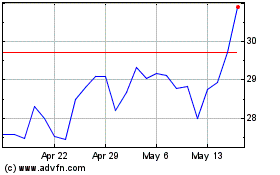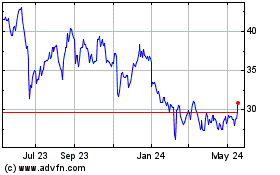Mercury Systems, Inc. (NASDAQ: MRCY, www.mrcy.com), a technology
company that delivers mission-critical processing power to the
edge, today announced the expansion of its portfolio of Direct RF
digital signal processing products that use Altera™ Agilex FPGAs to
detect and process emissions from a wide portion of the
electromagnetic spectrum.
Direct RF components and modules directly digitize radio
frequency signals at the antenna signal frequency, eliminating the
analog signal down conversion stages required by legacy hardware.
This approach requires extremely fast converters, high-bandwidth
digital data links, and powerful real-time digital signal
processing. The results are reductions in size, weight, power,
cost, and latency that can benefit a variety of radar,
communications, electronic warfare, SIGINT, and industrial
applications.
In January, Mercury introduced the DRF2580, a playing card-size
system-on-module (SOM) based on the Intel Agilex 9 SoC FPGA AGRW014
that converts between analog and digital signals at 64 Gigasamples
per second. The company now offers the DRF4580L, a
small-form-factor module that incorporates the DRF2580 SOM within a
ruggedized, conduction-cooled enclosure that is ready for defense
applications. The product comes with Mercury’s Navigator® Board
Support Package and FPGA Design Kit that allow customers to develop
custom IP for the module that can be installed within hours.
Mercury delivered the first DRF4580L unit to a customer in
August.
“We continue to innovate to enhance the Mercury Processing
Platform and make the latest commercial technologies available to
the defense industrial base,” said Ken Hermanny, Mercury’s Vice
President of Signal Technologies. “With a growing portfolio of
products that make Direct RF spectrum digitization possible, our
customers now have more options to deploy this technology to
capture, process, and exploit signals at the edge.”
“Altera Agilex 9 SoC FPGAs deliver high-performance RF
digitization capabilities in SWAP constrained environments that can
now be placed closer to the sensor," said John Sotir, Senior
Director, Military Aerospace and Government Business and
State-of-the-Art Heterogeneous Integration Packaging (SHIP) at
Altera, an Intel Company. "By collaborating with Mercury, a trusted
partner in transforming commercial technology for aerospace and
defense applications, we are able to deliver this latest technology
to our customers developing future radar, electronic warfare, and
mission-critical applications."
The DRF4580L features:
- 6.4" x 6.4" x 1.7" form factor
- Four 64 GSPS A/D and D/A converters
- Altera Agilex 9 SoC FPGA AGRW014
- 16 GB DDR4 SDRAM
- Four 100 GigE optical interfaces
- Ruggedized and conduction-cooled options
- Optional fan kit for table-top development
- FPGA design kit for custom IP development
- Board Support Package (BSP) for software development
Mercury will be showcasing the DRF4580L at booth 1642 at the
Air, Space & Cyber Conference in National Harbor, Md.,
September 16-18.
Mercury Systems – Innovation that
matters® Mercury Systems is a technology company that
delivers mission-critical processing power to the edge, making
advanced technologies profoundly more accessible for today’s most
challenging aerospace and defense missions. The Mercury Processing
Platform allows customers to tap into innovative capabilities from
silicon to system scale, turning data into decisions on timelines
that matter. Mercury’s products and solutions are deployed in more
than 300 programs and across 35 countries, enabling a broad range
of applications in mission computing, sensor processing, command
and control, and communications. Mercury is headquartered in
Andover, Massachusetts, and has 23 locations worldwide. To learn
more, visit mrcy.com. (Nasdaq: MRCY)
Forward-Looking Safe Harbor Statement This
press release contains certain forward-looking statements, as that
term is defined in the Private Securities Litigation Reform Act of
1995, including those relating to the Company's focus on enhanced
execution of the Company's strategic plan. You can identify these
statements by the words “may,” “will,” “could,” “should,” “would,”
“plans,” “expects,” “anticipates,” “continue,” “estimate,”
“project,” “intend,” “likely,” “forecast,” “probable,” “potential,”
and similar expressions. These forward-looking statements involve
risks and uncertainties that could cause actual results to differ
materially from those projected or anticipated. Such risks and
uncertainties include, but are not limited to, continued funding of
defense programs, the timing and amounts of such funding, general
economic and business conditions, including unforeseen weakness in
the Company’s markets, effects of any U.S. federal government
shutdown or extended continuing resolution, effects of geopolitical
unrest and regional conflicts, competition, changes in technology
and methods of marketing, delays in or cost increases related to
completing development, engineering and manufacturing programs,
changes in customer order patterns, changes in product mix,
continued success in technological advances and delivering
technological innovations, changes in, or in the U.S. government’s
interpretation of, federal export control or procurement rules and
regulations, changes in, or in the interpretation or enforcement
of, environmental rules and regulations, market acceptance of the
Company's products, shortages in or delays in receiving components,
supply chain delays or volatility for critical components,
production delays or unanticipated expenses including due to
quality issues or manufacturing execution issues, capacity
underutilization, increases in scrap or inventory write-offs,
failure to achieve or maintain manufacturing quality
certifications, such as AS9100, the impact of supply chain
disruption, inflation and labor shortages, among other things, on
program execution and the resulting effect on customer
satisfaction, inability to fully realize the expected benefits from
acquisitions, restructurings, and operational efficiency
initiatives or delays in realizing such benefits, challenges in
integrating acquired businesses and achieving anticipated
synergies, effects of shareholder activism, increases in interest
rates, changes to industrial security and cyber-security
regulations and requirements and impacts from any cyber or insider
threat events, changes in tax rates or tax regulations, changes to
interest rate swaps or other cash flow hedging arrangements,
changes to generally accepted accounting principles, difficulties
in retaining key employees and customers, litigation, including the
dispute arising with the former CEO over his resignation,
unanticipated costs under fixed-price service and system
integration engagements, and various other factors beyond our
control. These risks and uncertainties also include such additional
risk factors as are discussed in the Company's filings with the
U.S. Securities and Exchange Commission, including its Annual
Report on Form 10-K for the fiscal year ended June 28, 2024 and
subsequent Quarterly Reports on Form 10-Q and Current Reports on
Form 8-K. The Company cautions readers not to place undue reliance
upon any such forward-looking statements, which speak only as of
the date made. The Company undertakes no obligation to update any
forward-looking statement to reflect events or circumstances after
the date on which such statement is made.
INVESTOR CONTACTDavid FarnsworthChief Financial
OfficerDavid.Farnsworth@mrcy.com
MEDIA CONTACTTurner BrintonSenior Director,
Corporate Communications Turner.Brinton@mrcy.com
A photo accompanying this announcement is available at
https://www.globenewswire.com/NewsRoom/AttachmentNg/0da2c7e2-21ca-4216-ac53-b4ba2a1a7918
Mercury Systems (NASDAQ:MRCY)
Historical Stock Chart
From Jan 2025 to Feb 2025

Mercury Systems (NASDAQ:MRCY)
Historical Stock Chart
From Feb 2024 to Feb 2025
